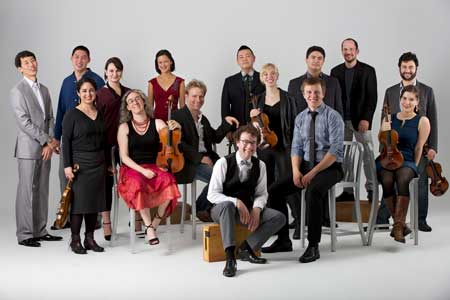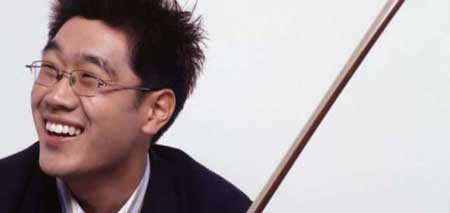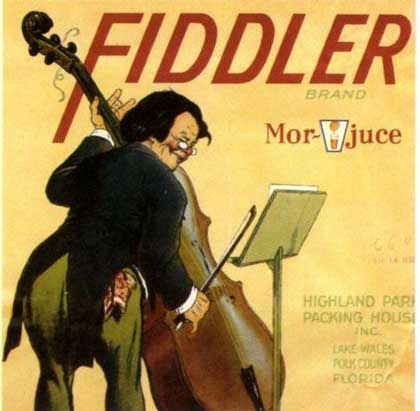Concert
A Far Cry
Jordan Hall
Symphony Hall area
September 13, 2019 8:00pm
Luciano Berio, Duetti per due violini
Reiko Yamada, New Shadows in the Raw Light of Darkness
Ludwig van Beethoven, Violin Concerto in D major
Soovim Kim, violin
Violin: Alison Kim; Chaterine Cosbey, Domenic Salerni, Jae Cosmos Lee, Katherine Winterstein, Keiko Tokunaga, Megumi Stohs Lewis, Rachel Kitagawa Shapiro, Robyn Bollinger; Viola: Caitlin Lynch, Colin Brookes, Jason Fisher, Sarah Darling; Cello: Kee Kim, Michael Unterman, RafaelPopper-Keizer; Bass: Charles Clements; Karl Doty; Flute:Coor Nelson; Oboe: Ben Fox, Nancy Dimock; Clarinet: Rane Moore, Romie de Guise-Langlois; Bassoon: Hazel Malcolmson, Naho Zhu; Horn: Hazel Dean Davis, Nick Castellano; Trumpet: Andrew Sorg, Michael Dobrinski; Timpani: Jonathan Hess; Harpsichord: John McKean

aka, less formally, “The Criers”
Photo: Courtesy of A Far Cry
They are full of surprises, and what wonderful ones they always are. Boston’s inimitable A Far Cry brings together its own distinctive brand of the traditional and the newly conceived in a fresh and bold style presented with enthusiasm, verve, and the highest degree of professionalism.
What’s amazing is how equally virtuosic all of these players are, how well they perform as an ensemble without any apparent ego-tripping, and how much fun they seem to have together.
They are, indeed, a democratic ensemble, which means that they have no official leader, no conductor, and no hierarchies. They all take turns and they all shine. It’s kind of incredible.
The sixth Brandenburg concerto, which opened the program, features exactly zero violins, a pretty bold move on the part of the surreptitiously inventive genius from Leipzig. Always appearing in what might seem like traditional garb, Bach is that kind of guy who places the bright yellow scarf where you would just not expect it. He’s always coherent and refined, but when he takes a left turn he does it exquisitely.
The two violists who took charge of this piece, Jason Fisher and Sarah Darling, played with such gusto and communicative intensity that it lifted what one might easily hear as just another rendition of an old chestnut into the outer reaches of exquisitude. Constantly on the move, always bending, gesticulating, bouncing with the phrases, the two of them turned the engine of pleasure and surprise over again and again.
The three cellos – Michael Unterman, Rafi Popper-Keizer, and Kee Kim – were also great, sitting in line a little like The Three Tenors, they spoke with a singular voice and with sensitively nuanced moderation.
The bass and keyboard continuo were also carried off gracefully.
Though, indeed, the instruments were not obviously muted, they sounded to some extent as though they were, played with a delicate charm appropriate to the instrumentation of the age. It was a great effect.
When I saw that five sections of Berio’s violin duets were next on the program, I did wonder which of the two Far Cry violinists might rise to the occasion. Imagine my surprise when ten violinists stepped onto the stage and formed a line, two by two. As each section came up, two new violinists appeared take on the challenge. It was a terrific conceit, and all of the violinists were so outstanding that one could barely catch one’s breath over the virtuosity of any given pair before the next pair took one’s breath away all over again.
Reiko Yamada’s commissioned piece New Shadows in the Raw Light of Darkness finished out the first half.
After the intermission, Robyn Bollinger, Far Cry violinist and curator of this program, spoke briefly about her love of Aristotle gained during university training and her appreciation for the model of balance and moderation he outlines in his Nichomachean Ethics. Drawing a parallel to the guidance of her NEC violin teacher, now colleague and friend, Soovin Kim, and to the example of his style of playing, she set the stage for Kim’s masterful, and interestingly evolving, rendering of the Beethoven Violin Concerto.

Photo: The Violin Channel
Beginning with a kind of stoic grace that served as a medium for his obvious technical facility, Kim’s interpretation was, at the outset, clear, direct, but not replete with the sort of turbulent emotion that one feels always brimming under Beethoven’s cover. As the piece progressed, however, Kim’s intensity increased. His utter confidence transmuted into a fierce and resolute interpretation which ultimately well suited that Beethovian requirement for conviction and verve. Though his style leans more towards clarity and directness rather than towards a highly shaped lyricism, the power and ferocity, along with the sheer virtuosity, made for an excitingly evolved interpretation. That delivered balance of restraint and intensity clearly brought to life the Aristotelian image of which Bollinger spoke and gave potent reference to the philosophical title of the program.

Some further, a bit more detailed, notes on the performance:
J. S. Bach, Brandenburg Concerto No. 6
1) Allegro moderato
No violins, but those violas are energetic and wonderful. Three cellos: nice to hear how artfully they divide things up. The fugue among the cellos is exquisitely intimate. Everything is touchingly muted, rounding out the already bassified end of things. It’s great to watch the two violists go at it. Beautiful balance and restraint throughout. The violists truly make this a sweeping and energetic intro.
2) Adagio, ma non tanto
Lilting, graceful, subtle. Restraint and grace are the watchwords here. Two violas handle the truly syncopated interlude deftly. Subtly persuasive cellos, with ongoing support from bass and harpsichord.
3) Allegro
Ah, that dashing bucolic theme. The violists do a great job to keep the ends tied down. And the cellos hold the running line on the bottom without breaking a sweat. It’s a dash through the country on elegant horses but it’s not snobby, just forthright and clear. Sarah Darling’s Viola 2 does such a great job of echoing Jason Fisher’s Viola 1. Love that subtle change of key at the end. And when that slight shock comes, you think they’re just ending, but then they go back again for more, slightly differently and wonderfully.
Luciano Berio, Duetti per due violini
But it’s really 10 violins, two at a time. How cool is that!
2) This is not a dialogue as much as two wanderings that finally find one another.
6) Two gypsy violinists face off with a bit of a competitive edge but with mutual flair and passion. Though they keep up the ferocious fight, how nicely they come together in the end.
8) A workers’ struggle. A plea for justice. Stately and paced but declaratively distant. When they whisper at the end they are most persuasive.
33) Laser lights flashing across one another. This is a dance of dreams, and how nicely they invoke one another’s gestures. Their mutual spiccatos are frighteningly accurate and coordinated. An airy, cosmic finish to a display of virtuosic fanaticism.
20) They all scrape a frenzied note repeatedly, a hailstorm on a beach. Then emerge traded episodic phrases like reasons heard then forgotten followed by a collective scream, a statement of plight. They return to the frenzied scratching and then break into a forest of crickets and cicadas chirping wildly to life.
Reiko Yamada, New Shadows in the Raw Light of Darkness
The full band, more or less. It’s a cinematic opening – sweeping, passionate, cosmic and ethereal. Violins draw a dark and distant landscape as the violin lead, Megumi Stohs Lewis, dances with a light saber through the wilderness. All top notch musicians, one better than the next. A dreamy, lilting, middle section, full of calls and answers. They meander and wander in conversation. Lewis, the violin soloist, offers a song plaintive in its own unique way. The pastiches grow and merge. Flutterings and innuendoes spar. Beautifully moderated citations conspire with an undergrowth of collective intention. A ferocity ensues that dissolved into dissipating, lonely, almost inadvertent dispersion, at the close.
L.V. Beethoven, Violin Concerto in D major
Soovim Kim, violin
1) Allegro ma non troppo
Begins so silent and delicately with Jonathan Hess’ tympani. These musicians are all such virtuosi, but they play with such camaraderie. This opening is all so about balance and restraint. Kim enters with delicacy, his achievement of the high notes effortless and pristine. This is Apollonian playing – clear, direct, precise, nuanced – achieving luminosity of tone with a straightforward lyricism. It is distinctively capable playing which places grace over passion. A wonderful control over the arpeggio section. Kim exhibits utter confidence in extract the tone he wants in every instance. The cadenza is limpid, guiding wild runs into ethereality. Technically majestic, he weaves notes like filigree, as the the orchestra re-enters with such subtly managed pizzicato.
2) Larghetto
Stately! The Queen has arrived, but she is, beneath the garb, indeed herself. The horns enter like beacons, clearing the pathway for the violin’s delicate adventurings. Kim’s great delicacy in the middle section. His rendition, particularly in this middle section, sonorous and beautiful. The orchestra’s transition to the Rondo is significant and decisive.
3) Rondo: Allegro
Here Kim’s playing becomes luminous, not heavyweight, traveling with a light dance step. In the modal section, he offers a plaintive lyricism and really begins to sing. With the bassoon pairing, the line is resoundingly lovely, and in the fierce double-stop section he really seems to be having fun. Masterful interpretation of the third movement cadenza – here he really pulls out all the stops – yet, with the pause before the end, makes for a judiciousness that paves the way for the dramatic closing.
– BADMan
Leave a Reply